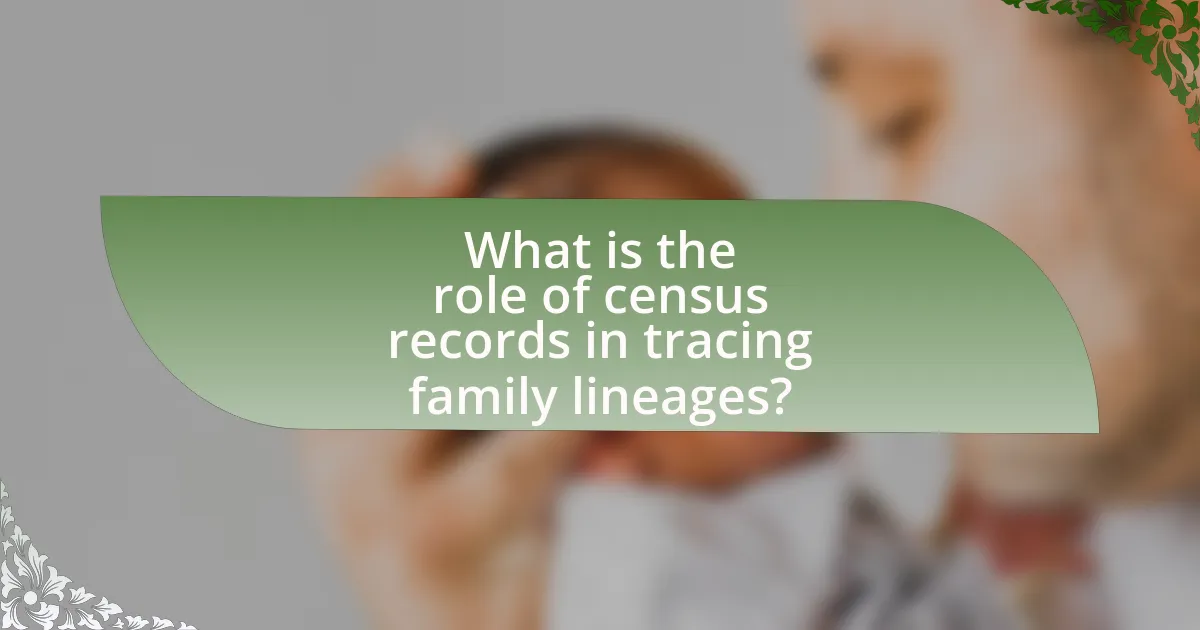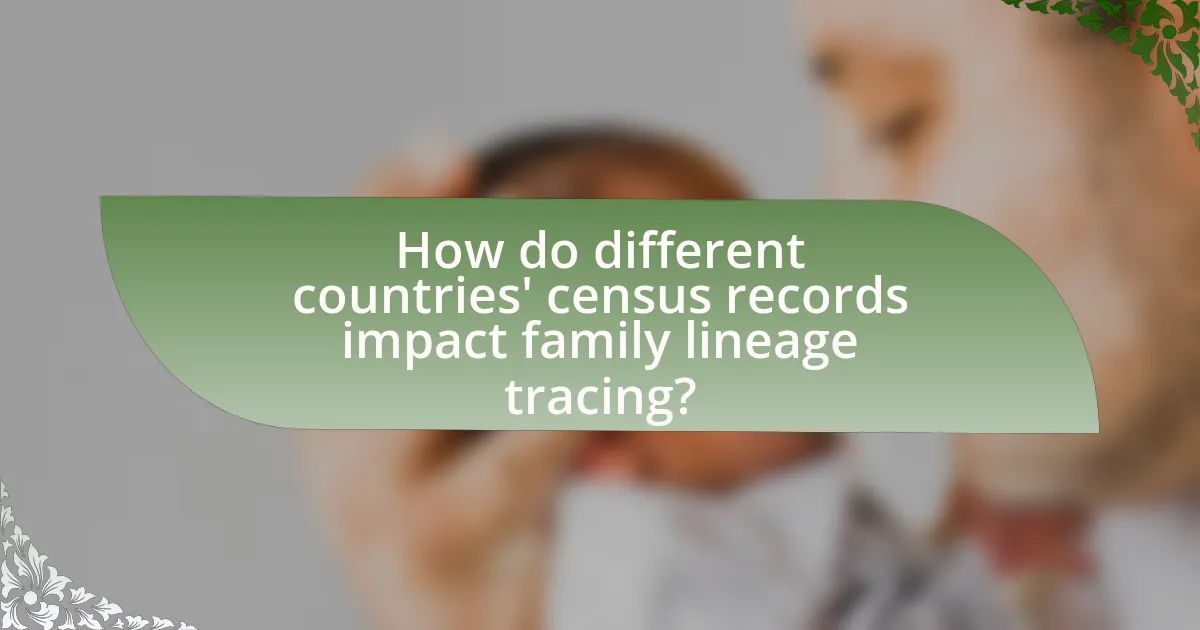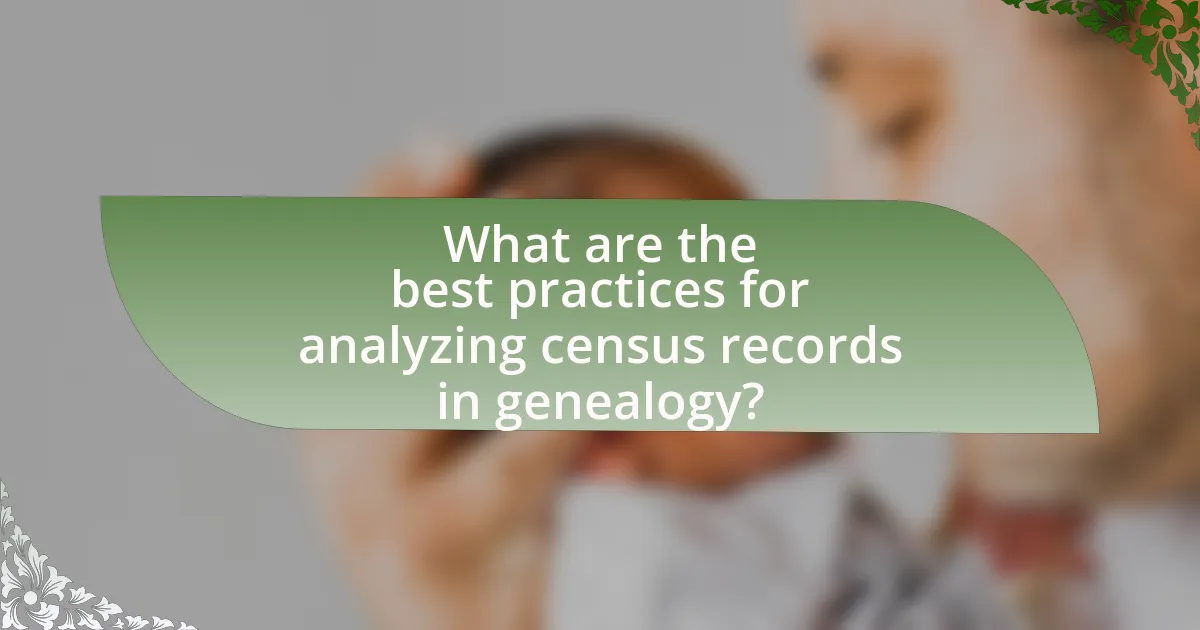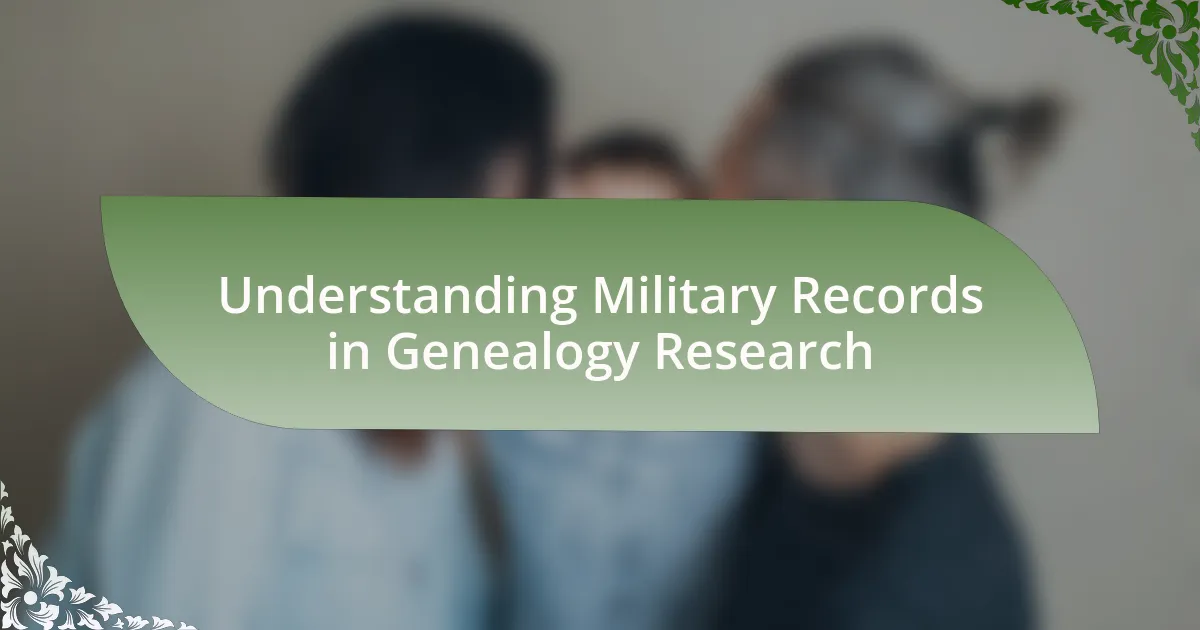Census records are essential tools for tracing family lineages, providing detailed demographic information such as names, ages, birthplaces, and relationships within households. This article explores the significance of census records in genealogical research, highlighting how they document family structures, reflect changes in family dynamics over time, and offer unique insights compared to other historical documents. It also addresses the challenges researchers face, including inaccuracies and gaps in data, and outlines best practices for effectively utilizing these records to construct comprehensive family trees. Additionally, the article examines variations in census record-keeping across different countries and the implications of historical events on data availability.
What is the role of census records in tracing family lineages?

Census records play a crucial role in tracing family lineages by providing detailed demographic information about individuals and households at specific points in time. These records typically include names, ages, birthplaces, relationships, and occupations, which help genealogists establish connections between ancestors and descendants. For example, the U.S. Census, conducted every ten years since 1790, offers a wealth of data that can reveal family structures and migration patterns, allowing researchers to build comprehensive family trees. The accuracy and consistency of census data over decades make it a reliable resource for verifying familial relationships and understanding historical contexts.
How do census records provide information about family structures?
Census records provide detailed information about family structures by documenting household members, their relationships, and demographic data. Each census typically includes names, ages, genders, and relationships to the head of the household, allowing researchers to construct family trees and understand lineage. For example, the U.S. Census Bureau’s decennial census has collected this information since 1790, enabling the analysis of family dynamics over time, such as changes in household size, composition, and the prevalence of extended families. This data is crucial for genealogical research, as it helps trace ancestry and understand familial connections across generations.
What specific details can be found in census records?
Census records contain specific details such as names, ages, genders, relationships to head of household, birthplaces, occupations, and residence information. These records provide a snapshot of the population at a given time, allowing researchers to trace family lineages effectively. For example, the U.S. Census of 1940 recorded over 132 million individuals, detailing their demographic information, which is crucial for genealogical research.
How do census records reflect changes in family dynamics over time?
Census records reflect changes in family dynamics over time by documenting shifts in household composition, family structures, and demographic trends. For instance, historical census data shows a transition from extended family households to nuclear family units, particularly in the 20th century, as urbanization increased and societal norms evolved. Additionally, census records reveal trends such as rising divorce rates, single-parent households, and cohabitation, which indicate changing societal attitudes towards marriage and family. The U.S. Census Bureau reported that the percentage of single-parent families rose from 7% in 1960 to 27% in 2020, illustrating significant shifts in family dynamics. These records serve as a vital resource for understanding how economic, social, and cultural factors influence family structures over time.
Why are census records considered vital for genealogical research?
Census records are considered vital for genealogical research because they provide comprehensive data on individuals and families at specific points in time. These records typically include names, ages, relationships, occupations, and places of residence, which are essential for constructing family trees and understanding lineage. For example, the U.S. Census, conducted every ten years since 1790, offers a wealth of information that allows researchers to trace ancestry, identify family connections, and analyze demographic changes over generations. The accuracy and consistency of census data make it a foundational resource for genealogists seeking to establish historical context and verify familial relationships.
What unique insights do census records offer compared to other historical documents?
Census records provide unique insights into demographic trends, household structures, and population movements that are often not captured in other historical documents. Unlike birth or marriage certificates, which focus on individual events, census records compile comprehensive data on entire households, including names, ages, relationships, occupations, and places of birth. This aggregated information allows researchers to analyze family dynamics, migration patterns, and socio-economic conditions over time. For example, the U.S. Census of 1900 included detailed questions about the number of children born to women, which helps historians understand fertility rates and family size during that period. Such specific data points are rarely found in other historical records, making census records invaluable for tracing family lineages and understanding historical contexts.
How do census records help in establishing family connections?
Census records help establish family connections by providing detailed information about individuals and their relationships within households. These records typically include names, ages, birthplaces, and family roles, allowing researchers to trace lineage and identify familial ties across generations. For example, the U.S. Census, conducted every ten years since 1790, has documented family structures, revealing connections such as parent-child relationships and sibling placements, which are crucial for genealogical research. This data enables individuals to construct family trees and understand their ancestry more comprehensively.
What challenges do researchers face when using census records?
Researchers face several challenges when using census records, including incomplete data, inaccuracies, and accessibility issues. Incomplete data arises when certain individuals or households are not recorded, leading to gaps in family lineage information. Inaccuracies can occur due to transcription errors or misreporting by respondents, which can distort the historical record. Accessibility issues may stem from restrictions on accessing certain census records due to privacy laws, particularly for more recent data, limiting researchers’ ability to obtain comprehensive information. These challenges complicate the process of tracing family lineages effectively.
How can inaccuracies in census data affect family lineage tracing?
Inaccuracies in census data can significantly hinder family lineage tracing by providing incorrect information about family relationships, locations, and historical contexts. For instance, if a census inaccurately lists individuals as unrelated or misidentifies their ages, it can lead researchers to erroneous conclusions about familial connections. Historical records, such as the 1940 U.S. Census, show that misreported data can result in gaps in family trees, as researchers rely on these records to establish lineage. Furthermore, discrepancies in names or spellings can complicate searches, making it difficult to link generations accurately. Thus, the reliability of census data is crucial for effective family lineage tracing.
What are the limitations of census records in genealogical research?
Census records have several limitations in genealogical research, primarily due to inaccuracies and gaps in the data. These records may contain errors such as misspellings of names, incorrect ages, or incomplete information, which can lead to confusion when tracing family lineages. Additionally, census records are only collected at specific intervals, often every ten years, meaning they may not capture significant life events or changes that occur between censuses. Furthermore, certain populations, such as enslaved individuals or those living in transient conditions, may be underrepresented or misclassified, resulting in incomplete family histories. These factors collectively hinder the reliability and comprehensiveness of census records for genealogical purposes.
How can researchers effectively utilize census records?
Researchers can effectively utilize census records by systematically analyzing demographic data to trace family lineages. Census records provide detailed information such as names, ages, birthplaces, and family relationships, which are crucial for constructing family trees. For example, the U.S. Census Bureau’s decennial census has collected data since 1790, allowing researchers to track changes in family structures over time. By cross-referencing census data with other historical records, such as birth and death certificates, researchers can validate lineage connections and uncover ancestral histories. This methodical approach enhances the accuracy of genealogical research and provides a comprehensive understanding of familial ties.
What strategies enhance the search for family lineages using census records?
Utilizing specific strategies significantly enhances the search for family lineages using census records. First, researchers should focus on understanding the historical context of the census data, including the years when specific census records were taken, as this can provide insights into family structures and migration patterns. For example, the U.S. Census of 1850 was the first to list all household members by name, which is crucial for identifying family relationships.
Additionally, cross-referencing census records with other documents, such as birth, marriage, and death certificates, can help verify family connections and fill in gaps. Utilizing online databases and genealogy websites that aggregate census data can streamline the search process, allowing for easier access to records and potential connections with other researchers.
Moreover, employing advanced search techniques, such as using wildcards for name variations and searching by location, can yield more comprehensive results. Understanding the limitations of census records, such as inaccuracies or missing data, is also essential for interpreting findings correctly. These strategies collectively enhance the effectiveness of tracing family lineages through census records.
How can cross-referencing census records with other documents improve accuracy?
Cross-referencing census records with other documents enhances accuracy by validating information through multiple sources. For instance, comparing census data with birth, marriage, and death certificates can confirm names, dates, and relationships, reducing the likelihood of errors. Historical studies indicate that discrepancies in family trees often arise from reliance on a single source; thus, integrating various records leads to a more comprehensive and reliable lineage. This method is supported by genealogical research practices, which emphasize the importance of corroborating data to establish factual family histories.
What tools and resources are available for accessing census records?
Various tools and resources are available for accessing census records, including online databases, government archives, and genealogical websites. Online databases such as Ancestry.com and FamilySearch.org provide extensive collections of digitized census records, allowing users to search by name, location, and year. Government archives, like the National Archives in the United States, offer access to original census documents and microfilm copies. Additionally, local libraries often provide access to census records and related resources, enhancing the ability to trace family lineages effectively.
How do different countries’ census records impact family lineage tracing?

Different countries’ census records significantly impact family lineage tracing by providing essential demographic information, such as names, ages, relationships, and locations of individuals within households. For instance, the United States Census, conducted every ten years since 1790, offers a wealth of data that allows genealogists to track family movements, changes in household composition, and connections across generations. Similarly, the UK Census, which dates back to 1801, includes detailed records that can reveal family structures and migration patterns. These records serve as primary sources for researchers, enabling them to construct accurate family trees and understand historical contexts. The availability and accessibility of these census records vary by country, influencing the ease with which individuals can trace their lineage; for example, some countries have digitized their records, while others maintain them in physical archives, affecting research efficiency.
What variations exist in census record-keeping across countries?
Census record-keeping varies significantly across countries in terms of methodology, frequency, and data collected. For instance, the United States conducts a decennial census that includes detailed demographic information, while countries like Canada conduct a mandatory long-form census every five years, focusing on a broader range of social and economic data. In contrast, some nations, such as India, utilize a continuous population registration system that updates demographic information regularly rather than relying solely on periodic censuses. Additionally, privacy laws and cultural attitudes towards data sharing influence the extent of information collected; for example, Scandinavian countries often have more comprehensive public access to census data compared to countries with stricter privacy regulations. These variations impact the availability and reliability of census records for tracing family lineages, as the depth and accessibility of data can differ widely.
How do cultural differences influence the information recorded in census documents?
Cultural differences significantly influence the information recorded in census documents by shaping how individuals identify themselves and what data they choose to disclose. For example, in multicultural societies, individuals may identify with multiple ethnicities or nationalities, leading to varied responses in racial and ethnic categories. This can result in underrepresentation or misrepresentation of certain groups in census data. Additionally, cultural norms regarding family structure can affect how households are reported, such as the inclusion of extended family members or non-traditional living arrangements. Historical context also plays a role; for instance, in the United States, the 2020 Census included a question on same-sex relationships, reflecting changing societal attitudes towards identities. These variations in self-identification and household composition directly impact the accuracy and completeness of census records, which are crucial for tracing family lineages and understanding demographic trends.
What are the implications of these variations for genealogical research?
Variations in census records significantly impact genealogical research by introducing inconsistencies in names, ages, and familial relationships. These discrepancies can lead to challenges in accurately tracing lineage, as researchers may encounter multiple entries for the same individual or conflicting information across different census years. For instance, a study by the National Archives indicates that name spellings often varied due to transcription errors or changes in literacy levels, complicating the identification of ancestors. Additionally, variations in reported ages can obscure timelines, making it difficult to establish a clear family tree. Therefore, genealogists must approach census data critically, cross-referencing with other historical documents to validate findings and construct accurate family histories.
How do historical events shape the availability of census records?
Historical events significantly influence the availability of census records by determining when and how these records are collected, preserved, or destroyed. For instance, wars, natural disasters, and political upheavals often lead to the loss or inaccessibility of census data; the U.S. Census of 1890 was largely destroyed in a fire, resulting in a gap for genealogical research. Additionally, changes in government policies regarding privacy and data retention can restrict access to more recent census records, as seen with the 72-year rule in the United States, which protects individual data until it is deemed historical. These factors collectively shape the landscape of available census records, impacting the ability to trace family lineages effectively.
What impact do wars and migrations have on census data collection?
Wars and migrations significantly disrupt census data collection by altering population stability and demographics. During wars, displacement of populations occurs, leading to undercounting in affected areas as individuals flee conflict zones or are unable to participate in the census process. For instance, the U.S. Census Bureau reported that the 2020 Census faced challenges due to the COVID-19 pandemic, which was exacerbated by ongoing conflicts in various regions, resulting in incomplete data. Similarly, migrations, whether voluntary or forced, can lead to inaccuracies as populations shift, making it difficult to capture an accurate snapshot of the population at a specific time. Historical examples include the mass migrations during World War II, which caused significant gaps in census data across Europe. These factors ultimately affect the reliability of census records, which are crucial for tracing family lineages and understanding demographic changes over time.
How can researchers navigate gaps in census records due to historical disruptions?
Researchers can navigate gaps in census records due to historical disruptions by utilizing alternative historical documents and records. These alternatives include church records, immigration records, military service records, and local government documents, which can provide complementary information about individuals and families during periods when census data is missing. For instance, church baptism and marriage records often contain vital information about family relationships and can fill in gaps left by incomplete census data. Additionally, the use of genealogical databases and DNA testing can help researchers connect with distant relatives and gather information that may not be available in census records. This multifaceted approach allows researchers to construct a more complete picture of family lineages despite the limitations posed by historical disruptions in census data.
What are the best practices for analyzing census records in genealogy?

The best practices for analyzing census records in genealogy include thorough examination of the records for accuracy, cross-referencing with other historical documents, and understanding the context of the census data. Analyzing census records requires careful attention to details such as names, ages, relationships, and locations, as these can provide critical insights into family structures and movements. Cross-referencing with birth, marriage, and death records enhances the reliability of the information gathered, while understanding the historical context, such as the reasons for census-taking and the socio-economic conditions of the time, can clarify discrepancies and enrich the analysis.
How can researchers ensure they are interpreting census data correctly?
Researchers can ensure they are interpreting census data correctly by cross-referencing the data with other historical records and utilizing statistical methods to analyze trends. Cross-referencing allows researchers to validate the accuracy of the census data against birth, marriage, and death records, which can reveal discrepancies or confirm information. Statistical methods, such as regression analysis, help identify patterns and anomalies within the data, providing a clearer understanding of demographic changes over time. Additionally, understanding the context in which the census was conducted, including the questions asked and the population surveyed, further aids in accurate interpretation.
What common mistakes should be avoided when analyzing census records?
Common mistakes to avoid when analyzing census records include overlooking variations in spelling of names, misinterpreting relationships listed in the records, and failing to consider the historical context of the data. Variations in spelling can lead to missed connections, as names may be recorded differently due to transcription errors or regional dialects. Misinterpretation of relationships, such as assuming that all individuals listed as “brother” or “sister” are biological relatives, can skew family lineage research. Additionally, not accounting for historical factors, such as migration patterns or changes in household structures over time, can result in inaccurate conclusions about family connections.
How can understanding historical context enhance data interpretation?
Understanding historical context enhances data interpretation by providing a framework for analyzing the circumstances surrounding the data collected. For instance, when examining census records, knowledge of the socio-economic conditions, migration patterns, and historical events during the census period allows researchers to better understand population changes and family structures. Historical context reveals why certain demographic trends occurred, such as the impact of the Great Depression on family sizes or the effects of World War II on migration. This contextual awareness leads to more accurate conclusions about lineage and ancestry, as it helps to explain anomalies or patterns in the data that might otherwise be misinterpreted.
What resources are available for learning more about census records?
Resources for learning more about census records include government archives, genealogical societies, and online databases. The U.S. Census Bureau provides access to historical census data and resources through its website, which includes tools for understanding census methodologies and data interpretation. Additionally, organizations like the National Archives and Records Administration offer guidance on accessing census records, including physical and digital collections. Online platforms such as Ancestry.com and FamilySearch.org host extensive databases of census records, along with tutorials and community forums for assistance. These resources collectively support individuals in tracing family lineages through comprehensive census data.
How can online databases and archives assist in accessing census records?
Online databases and archives facilitate access to census records by providing digital platforms where users can search, view, and download historical data. These resources often include indexed records, which allow for efficient searching by name, location, or year, significantly reducing the time and effort required to locate specific information. For instance, the U.S. Census Bureau’s online portal offers access to census data from 1790 to the present, enabling researchers to trace family lineages through various demographic details. Additionally, many genealogy websites, such as Ancestry.com and FamilySearch, aggregate census records and provide user-friendly tools for building family trees, enhancing the ability to connect historical data with personal ancestry.
What educational materials are recommended for beginners in genealogical research?
Recommended educational materials for beginners in genealogical research include books, online courses, and databases. Notable books such as “The Complete Beginner’s Guide to Genealogy” by John Smith provide foundational knowledge and practical tips. Online platforms like Ancestry.com and FamilySearch.org offer tutorials and access to census records, which are crucial for tracing family lineages. Additionally, local genealogical societies often provide workshops and resources tailored for beginners, enhancing their understanding of research methodologies and record interpretation.
What practical tips can help in tracing family lineages using census records?
To effectively trace family lineages using census records, start by gathering as much information as possible about your ancestors, including names, birth dates, and locations. This foundational data allows for targeted searches in census records, which are typically conducted every ten years in the United States, with the most recent available being from 1950. Utilize online databases such as Ancestry.com or FamilySearch.org, which provide access to digitized census records and often include search tools that can filter results by specific criteria.
Cross-reference information found in census records with other documents, such as birth, marriage, and death certificates, to verify relationships and details. Pay attention to the details in the census, such as household members, ages, and occupations, as these can provide insights into family structures and migration patterns. Additionally, consider the historical context of the census data, as changes in laws and societal norms can affect how information was recorded.
By systematically compiling and verifying data from multiple census years, you can build a more comprehensive picture of your family lineage.




